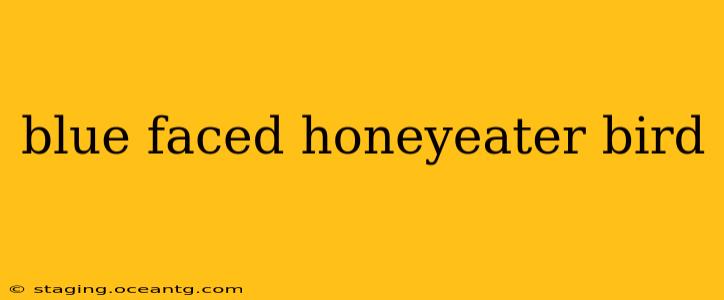The Blue-Faced Honeyeater ( Entomyzon cyanotis) is a striking and captivating bird, a true emblem of the Australian landscape. Its vibrant plumage and unique characteristics make it a favorite among birdwatchers and nature enthusiasts alike. This comprehensive guide delves into the fascinating world of the Blue-Faced Honeyeater, exploring its habitat, behavior, diet, and conservation status.
What is a Blue-Faced Honeyeater?
The Blue-Faced Honeyeater is a medium-sized honeyeater, easily identifiable by its distinctive blue facial markings. The adult bird boasts a predominantly grey-brown body with a rich chestnut-colored back and wings. The striking blue patches on its face, extending from the eye to the beak, are its most prominent feature. Males and females exhibit similar plumage. Their melodious calls and distinctive foraging behavior further contribute to their captivating nature.
What Does a Blue-Faced Honeyeater Eat?
What is the diet of a Blue-Faced Honeyeater? The Blue-Faced Honeyeater's diet primarily consists of nectar, supplementing this with insects, spiders, and fruits. They are highly adept at accessing nectar from various flowering plants, playing a crucial role in pollination. Their dietary flexibility allows them to adapt to changing environmental conditions.
Where Do Blue-Faced Honeyeaters Live?
What is the habitat of a Blue-Faced Honeyeater? Blue-Faced Honeyeaters are found across a wide range of eastern Australia, from coastal regions to inland woodlands. They are adaptable birds, inhabiting various habitats, including forests, woodlands, and even urban parks and gardens where flowering plants are abundant. Their preference for areas with diverse flowering plants influences their distribution.
Blue-Faced Honeyeater Behavior: A Social Bird
How do Blue-Faced Honeyeaters behave? These birds are often seen in pairs or small family groups, but larger flocks can form, especially outside of the breeding season. They are active and agile foragers, flitting between branches and flowers with remarkable dexterity. Their vocalizations, a series of melodious whistles and chirps, are frequently heard throughout their habitat. They are generally considered to be quite tame and approachable, especially in areas accustomed to human presence.
Blue-Faced Honeyeater Conservation Status
Are Blue-Faced Honeyeaters endangered? Currently, the Blue-Faced Honeyeater is not considered an endangered species. However, habitat loss due to deforestation and urbanization remains a significant threat. Maintaining diverse flowering plant communities is crucial for their continued survival, as nectar sources are essential for their diet and overall health. Conservation efforts focused on habitat preservation and restoration are essential to ensure the long-term survival of this beautiful species.
How to Attract Blue-Faced Honeyeaters to Your Garden
How can I attract Blue-Faced Honeyeaters to my garden? To attract Blue-Faced Honeyeaters to your garden, plant a variety of native flowering plants that provide nectar. Include species that flower throughout the year to ensure a continuous food source. Avoid the use of pesticides that could harm insects, a vital component of their diet. Providing a source of fresh water, like a birdbath, will also increase the chances of attracting these charming birds.
Frequently Asked Questions about Blue-Faced Honeyeaters
This section will be populated with more FAQs as they are identified through keyword research and analysis of user queries.
By understanding the Blue-Faced Honeyeater's habitat, behavior, and dietary needs, we can better appreciate its significance within the Australian ecosystem and actively contribute to its conservation. This remarkable bird continues to captivate and inspire, serving as a reminder of the beauty and diversity of the Australian bush.
